Before the sales even began, a shocking announcement turned the entire evening into an extended anti-climax. At the last minute, the Baltimore Museum of Art pulled works it had consigned by Clyfford Still and Brice Marden after donors threatened to withhold millions of dollars in horror and more than a dozen institutional bigwigs signed letters decrying the sell-off.
It was a shocking about-face from BMA director Christopher Bedford, a singular figure in the ranks of American museums who is steadfastly committed to the idea that deaccessioning old works from a homogeneous collection is the most efficient way to fill its holdings with new work by young artists of color. In an interview with the Baltimore Sun this week, Bedford accused anyone against his brash approach of making an “investment in a system of operating institutions that is very deeply centered in white power and white privilege.”
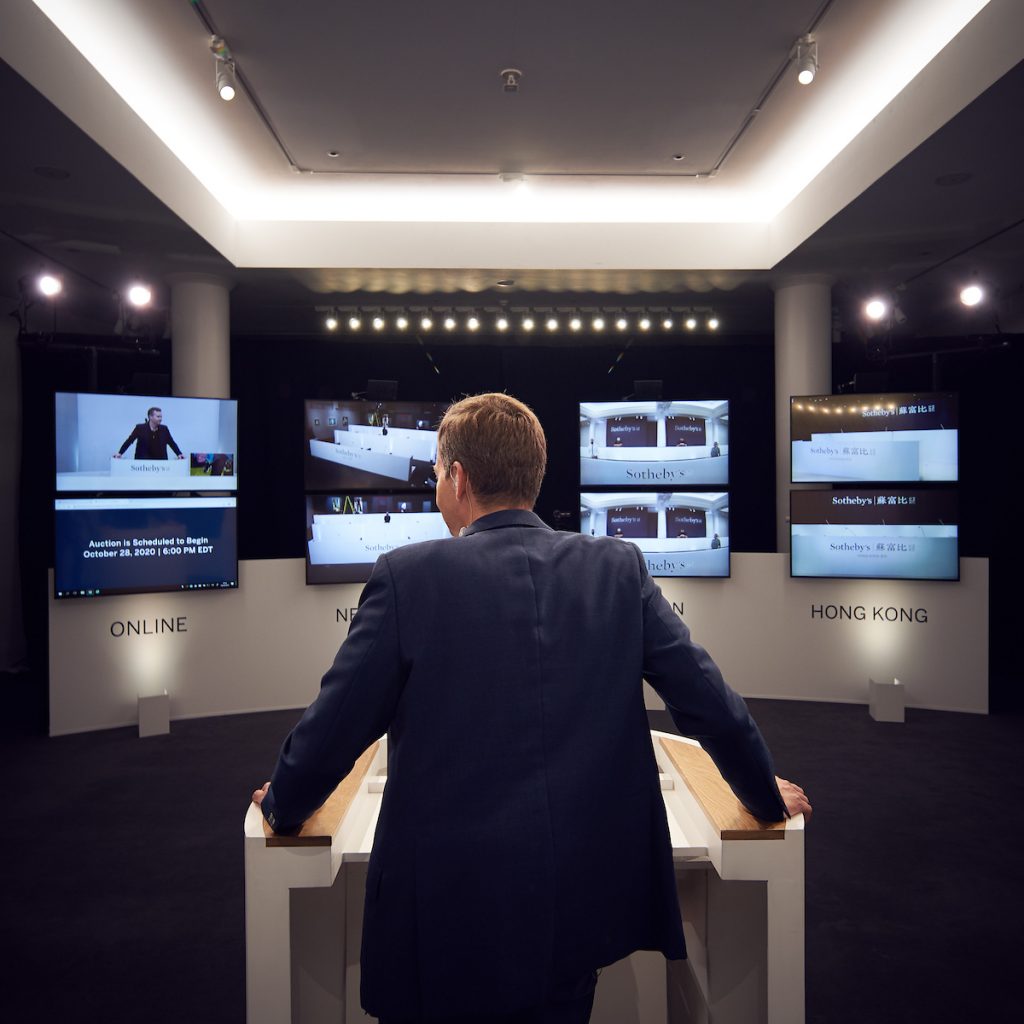
Oliver Barker at Sotheby’s London salesroom on October 28. Photo: Michael Bowles, Getty Images
But the petitioners won out in the nick of time, and the show had to go on sans the controversial lots. (Marden’s 3 [1987–88] was set to sell for between $10 million to $15 million and Still’s 1957-G [1957] was set to sell for between $12 million to $18 million.)
All told, Sotheby’s back-to-back postwar and contemporary and Impressionist and Modern sales grossed a combined hammer total of $238.7 million, just shy of the $239.2 million low estimate. With fees, the total was $283.9 million. (Final prices include the seller’s premium; pre-sale estimates do not.)
The sell-through rate was 97.4 percent by lot, and the Impressionist and Modern art auction was a white-glove sale (though two works had their low estimates adjusted down before the start of the auction, indicating they would not have sold initially).
Pre-Sale Sales
To the extent that these modest totals were a success, it was due in large part to work done ahead of time: 46 percent of the lots in the postwar and contemporary sale and 42 percent of the lots in the Imp-Mod sale carried guarantees or were owned by Sotheby’s.
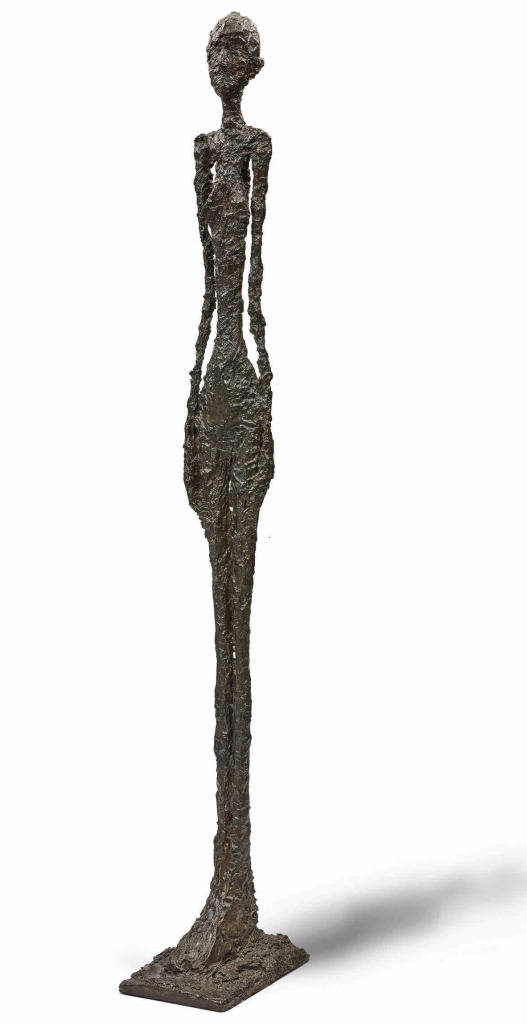
Alberto Giacometti, Grancde Femme I (Cast in 1960). Image courtesy Sotheby’s
But, notably, the top-line totals do not include two of the priciest lots from the Imp-Mod auction, which actually found buyers before the proceedings began. The house announced via email prior to the sale that Alberto Giacometti’s nine-foot sculpture Grand Femme I had sold via a sealed bid private sale. The consignor was former Revlon chairman Ron Perelman, who has been rapidly divesting himself of his art collection this season. While the house did not disclose the sale price, the minimum bid on the sculpture was $90 million, ensuring it was the night’s most expensive lot.
Another Giacometti, Femme de Venise IV, 1956, was also sold privately before the sale and pulled from the auction. It had an estimate of $14 million to $18 million; the price paid was not disclosed.
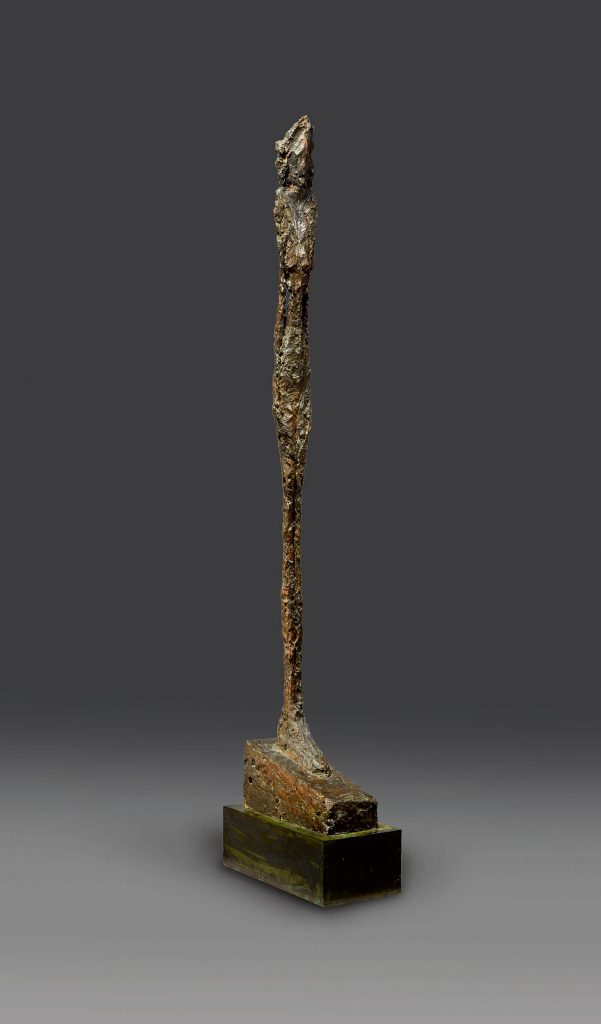
Giacometti, Femme Leoni (1958). Photo courtesy Sotheby’s.
Giacometti collectors had one more chance when Femme Leoni came on the block as the 11th lot of the Impressionist and Modern sale. Estimated at $20 million to $30 million, it hammered at $22.6 million to Yuki Terase after a tri-continental bidding war, with Terase in Hong Kong overcoming Brooke Lampley in New York and Helena Newman in London. With premium, the price was $25.9 million.
But first, auctioneer Oliver Barker had to navigate a hobbled but still spirited 41-lot postwar and contemporary sale that achieved a hammer total of $119.7 million, under its pre-sale low estimate of $128.2 million. With fees, the total was $142.8 million.
Categorical Promiscuity
Weeks after Christie’s made a splash by selling a T. Rex for $31.8 million in its postwar and contemporary art sale, Sotheby’s embraced the stunt of slotting non-art objects into its auction. The big lot of this portion of the night was not an artwork (or a dinosaur), but a trio of automobiles: three futuristic unique Alfa Romeos, which sold as a group for a hammer price of $13.25 million, short of the $14 million low estimate. With fees, the price was $15.5 million, and it was purchased for a client by Barney Ruprecht, the RM Sotheby’s senior specialist. (His father, Bill Ruprecht, was CEO of the auction house until 2014.)

Alfa Romeo, Berlina Aerodinamica Tecnica B.A.T. Photo by Ron Kimball © 2020 RM Sothebys
The bit of sporty vroom-vroom classiness was a highlight in a sale that desperately needed some oomph after getting the wind taken out of its sails by the Baltimore Museum bombshell. In addition to the absence of the BMA-owned lots, three other lots were pulled as well, and a Mark Rothko expected to bring in as much as $35 million failed to secure a single bidder, proving to be a pricey flop. The work was owned by Sotheby’s, and had gone through a twisty history of owners since Rothko painted it in the bowels of a former YMCA at 222 Bowery—later famed as The Bunker, a residence for William S. Burroughs and John Giorno—in the lead-up to his abortive suite of works that were commissioned for the Four Seasons but never shown.
Still, there were a few highlights during the lavishly produced livestream, which was perhaps the slickest-looking live art event in history. Sotheby’s owner Patrick Drahi clearly knows the value of good video production, as he also owns the streaming TV service Cheddar (it was airing the sale). Investing in content is his way of staying competitive in the social-distancing era: pre-show segments showed such luminaries as Adam Gopnik and Kurt Andersen palling around in the York Avenue showrooms, gabbing about Surrealists.
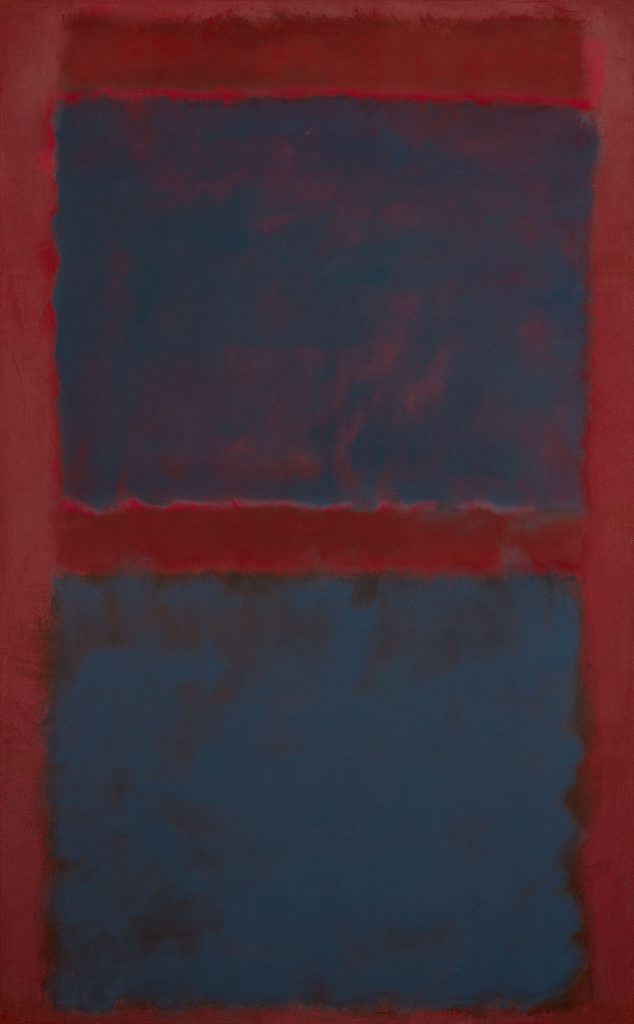
Mark Rothko, Untitled (Black on Maroon) (1958). Photo courtesy Sotheby’s.
Another seven-figure price was notched for a work by Matthew Wong, the promising young artist who died by suicide last year and has since become an art-market phenomenon. Tonight at Sotheby’s, the large 2018 painting Dialogue prompted a wave of bidding from all three feeds and eventually went to a client on the phone with Liz Sterling, a chairman with a focus on American art, for a hammer price of $1.37 million, or $1.68 million with fees. The figure was more than five times its high estimate of $300,000.
At a time when North American museums are taking advantage of relaxed deaccessioning rules, institutional provenance offered a boost: a lush Helen Frankenthaler consigned by the Palm Springs Art Museum sold for $4.7 million with fees over a high estimate of $3.5 million. A Carlo Mollino table from the Brooklyn Museum smashed high estimates, selling to a client on the phone with Max Moore for $5.2 million, or $6.2 million with fees.
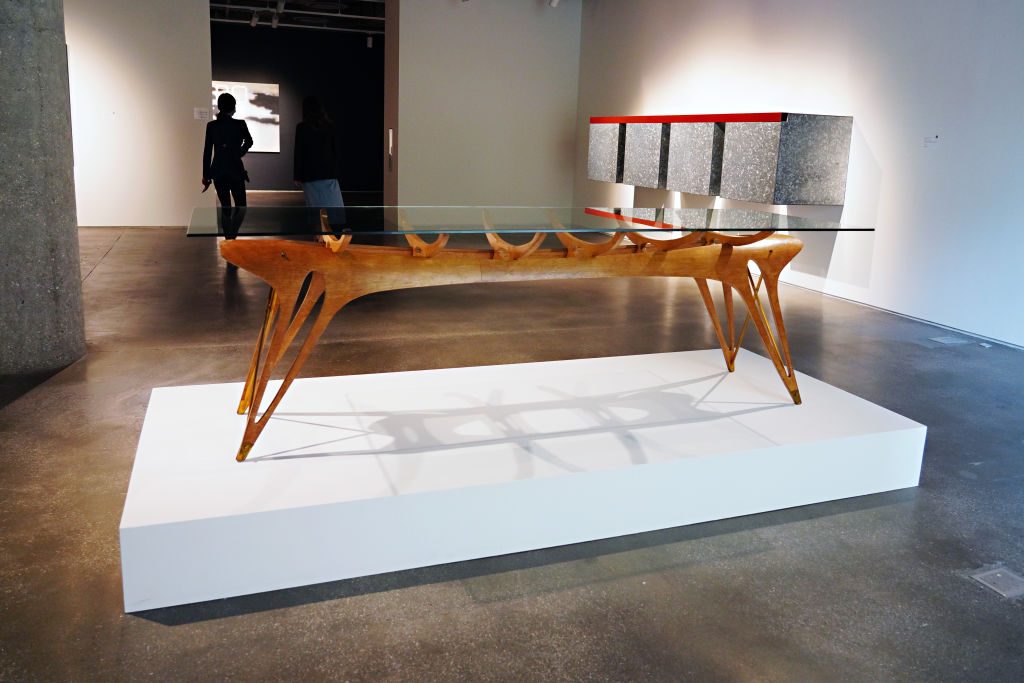
Carlo Mollino’s dining table consigned by the Brooklyn Museum and Donald Judd’s Untitled during at Sotheby’s on October 23, 2020 in New York City. Photo by Cindy Ord/Getty Images.
Two works by Basquiat from the collection of his late publisher Enrico Navarra also beat out their high estimates.
Middling Impressionist Action
Following the postwar sale, auctioneer Oliver Barker lifted the gavel on the 38-lot Impressionist and Modern art evening sale, with things running about 90 minutes behind schedule. He made up for the delay with a briskly paced sale that brought in a respectable $119.1 million, over a low estimate of $111 million. With fees, the total for the sale came to $141.1 million.
In addition to the Giacometti, the sale saw a $15.9 million Giorgio de Chirico establish a new record for the artist, and a Van Gogh hammer for $13.9 million for a with-fees price of $16 million.
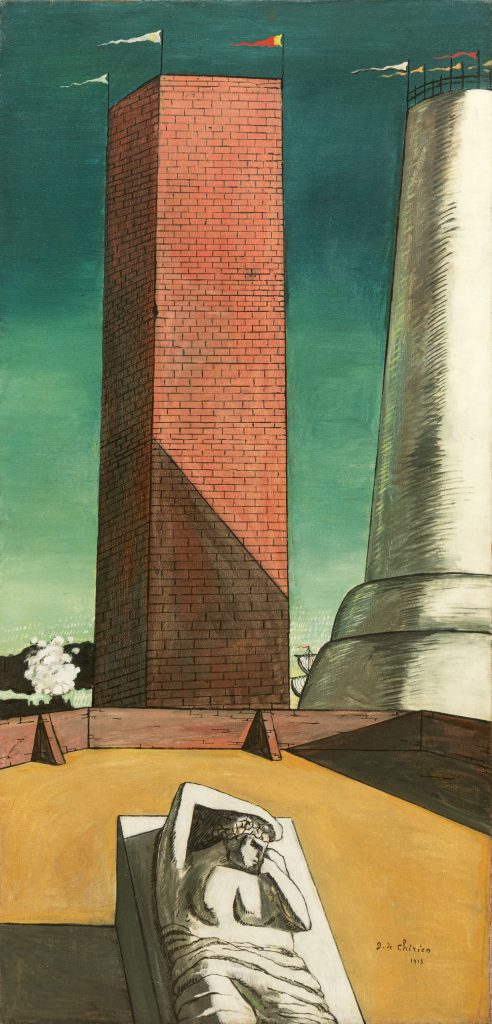
Giorgio de Chirico, Il Pomeriggio di Arianna Ariadnes Afternoon. (1913) Photo courtesy Sotheby’s.
After hours of off-loading artworks, the Sotheby’s team huddled virtually through the magic of streaming and led a cross-continental press conference. Despite the yanking of the BMA works and the yawns that faced the Rothko flop, the team was upbeat, noting that they pulled off a respectable sale in the face of still-intense constraints, and will continue to innovate through this period of adjustment.
“There were close to one million people watching tonight—as we went into lockdown and put our heads together, little did we know that we could get so many people to be tuning in and get interested in this business,” Barker said in the press conference after the sale. “As my colleague Amy Cappellazzo has said, ‘We used to be a live theater business, and now we’re a streaming service.'”















